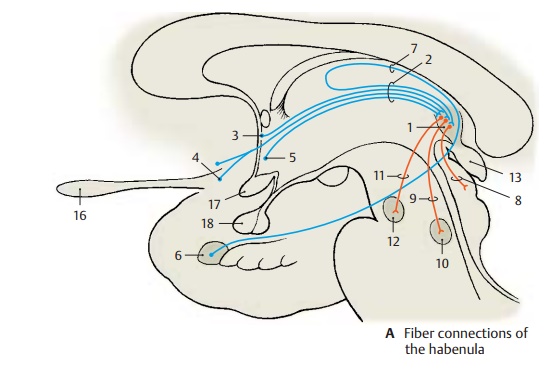Chapter: Human Nervous System and Sensory Organs : Diencephalon
Habenula - Epithalamus
Habenula
The habenula (A1) with its afferent and efferent pathways forms a relay system in which olfactory impulses are transmitted to efferent (salivatory and motor) nuclei of the brain stem. In this way, olfactory sensation is thought to affect food intake. The habenular nucleus contains numerous peptidergic neurons.

A16 Olfactory bulb.
A17 Chiasm.
A18 Hypophysis.
The afferent pathways reach the habenular nuclei via the medullary stria of the thalamus (A2). It contains fibers from the septal nuclei(A3), the anterior perforated substance (ol-factory area) (A4), and the preoptic region (A5). Furthermore, it receives fibers from the amygdaloid body (amygdala) (A6) cross-ing over from the terminal stria (A7).
The efferent pathways extend into the mid-brain. The habenulotectal tract (A8) transmits olfactory impulses to the superior colliculi. The habenulotegmental tract (A9) terminates in the dorsal tegmental nucleus (A10), from where there is a link to the posterior longi-tudinal fasciculus with connec-tions to the salivatory and motor nuclei of the masticatory and deglutitory muscles (olfactory stimuli leading to secretion of saliva and gastric juice). The habenulo-inter-peduncular tract,Meynert’s bundle(A11), ter-minates in the interpeduncular nucleus (A12) which is connected to various nuclei of the reticular formation.
Related Topics